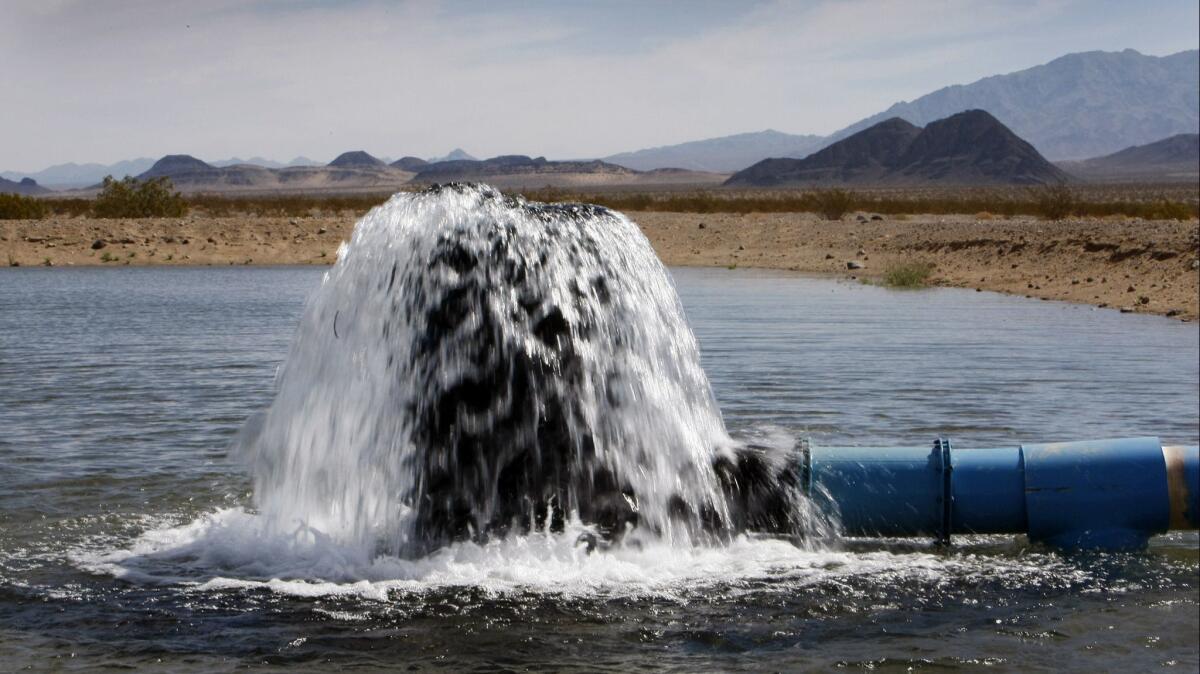Editorial: The Cadiz project to drain the desert is a bad idea

- Share via
There’s a tiny green patch of Mojave Desert, past Barstow but before Needles, north of Joshua Tree National Park and south of the Mojave National Preserve, where groundwater pumped from an aquifer under the arid landscape irrigates several hundred acres of crops. Rainfall that seeps from the adjacent mountains is sporadic, but sufficient to replenish what is taken from the ground while still leaving enough for the natural springs that sustain the bighorn sheep, desert tortoises and other threatened species that live in the environmentally fragile region.
But the private landowner, Cadiz Inc., is interested in more than growing a few lemons among the creosote and cactus. It wants to vastly increase the scale of pumping in order to pipe about 16 billion gallons of water a year to homes in distant Orange and Los Angeles counties. Cadiz has commissioned reports that, it says, show that natural processes would replenish the water at close to the rate at which it would be extracted.
The U.S. Geological Survey studied the land and the water and, in 2002, found otherwise. Its scientists concluded that the proposed pumping would far exceed the rate of natural refill. The National Park Service submitted comments in 2012 stating that Cadiz’s estimates are “3 to 16 times too high.” The Geological Survey, in 2017, reported that there was no information to lead it to change its 2002 conclusions.
Enter the Fray: First takes on the news of the minute »
And that ought to have been the end of it. Pumping water from the desert to homes thousands of miles away might have been an interesting idea in the abstract. But earth science experts who analyzed the data concluded that it wouldn’t work — at least, not without threatening the land, wildlife and vegetation that depend on it.
But the project survived a layer of California environmental review. Meanwhile, the Trump administration made the proposal an “Emergency and National Security” priority and reversed an Obama-era ruling that required federal approval for the pipe that would deliver the water across the desert. The current secretary of the interior, David Bernhardt, was a partner in the firm that represented Cadiz; the firm owns a stake in the project.
A bill in the state Legislature — Senate Bill 307 by Sen. Richard Roth (D-Riverside) — would require the project to be reviewed by the State Lands Commission and the Department of Fish and Wildlife. It ought not to be necessary, given the USGS findings. But when politics outflanks science, it doesn’t hurt to add a little more science. That’s especially true now, when California is finally seeing a generation of more responsible proposals for supplying urban water through recycling and other sustainable methods that don’t require extraction of natural resources from distant, and environmentally sensitive, lands.
Follow the Opinion section on Twitter @latimesopinion and Facebook.
More to Read
A cure for the common opinion
Get thought-provoking perspectives with our weekly newsletter.
You may occasionally receive promotional content from the Los Angeles Times.









